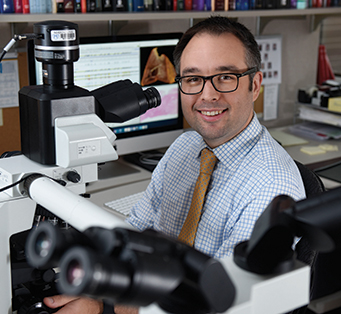Karen Titus
May 2016—The stories are haunting: a young, seemingly healthy athlete collapses on the playing field and dies. For Joseph Maleszewski, MD, section head of cardiovascular pathology, Mayo Clinic, Rochester, Minn., these deaths also seem sadly familiar, especially given his work with the NCAA on such cases. “Every community, it seems, has a story,” says Dr. Maleszewski, who is also associate professor, laboratory medicine and pathology, and associate professor, medicine. “A child died on the basketball court, on the football field, while running track. These young athlete deaths are not uncommon at all—or even young nonathlete deaths.”
Difficult as these stories are, they don’t end there.

“Basically, when you’re talking about endomyocardial biopsy, it makes sense to broadly dichotomize the issue into the two categories that make sense clinically: transplant related and nontransplant related,” says Dr. Joseph Maleszewski (right).
“A patient comes in, and they tell us, ‘I had a brother or sister die suddenly and young,’ and the pathologist who performed the autopsy suspected a cardiomyopathy or a heritable arrhythmia syndrome,” Dr. Maleszew-ski continues. “Maybe a parent has died. Or perhaps—most tragically—a parent comes in and says, ‘I’ve had a child die suddenly.’” The questions hang in the air. Will the same thing happen to me? To my other children?
“Everybody’s heard these stories,” says Dr. Maleszewski. But not everybody has answers.
“One of the nagging issues pathologists are dealing with is the nonuniformity in our approach to cardiac dissection and evaluation,” says Dr. Maleszewski. Particularly in the postmortem setting, he says, it’s less acceptable to obtain an expert’s opinion for cardiovascular disease, the way it is often done with neuropathology. One reason is cost. “And perhaps there’s not a good understanding of how important it is for these family members to understand the heritable implications in these cases.”
When it comes to cardiovascular mysteries, even the answers—if they finally come—can be surprising, says Stephen Cohle, MD, a cardiovascular pathologist with Michigan Pathology Specialists, which is affiliated with Spectrum Health, Grand Rapids, Mich. As Dr. Cohle has learned over the years, it doesn’t take a dramatic, sudden death to jolt pathologists.
Most of the endomyocardial biopsies Dr. Cohle interprets are tied to Spectrum’s heart transplant program. In addition to monitoring patients for rejection, Dr. Cohle examines explanted hearts—and sometimes encounters cases where the diagnosis that prompted the transplant was in error.

Dr. Cohle
“They needed to be transplanted—it’s not like these were otherwise healthy hearts,” says Dr. Cohle, who is also chief medical examiner for Kent County, Mich. Nevertheless, in two cases, he says, the diagnosis was simply nonischemic cardiomyopathy—the equivalent, he says, of “nobody knows the cause.” When he looked at the hearts, he found noncompaction of the left ventricle. “It was satisfying to come up with the actual diagnosis.” In other cases with an initial diagnosis of nonischemic cardiomyopathy (which precludes coronary artery disease), he’s found that CAD was indeed the culprit.
In stories like these, the denouement would appear to be an endomyocardial biopsy. As Dr. Cohle puts it, “There’s no substitute for actually looking.” Endomyocardial biopsies are a bit like the lottery, as it turns out. It costs to play, and the odds of winning may seem uncomfortably slim. But if you don’t play, you can’t win. And if you don’t look, you won’t see.
There’s good reason to look, says Heinz-Peter Schultheiss, MD, professor for internal medicine, cardiology, and intensive care, and chief of cardiology, Charité-Universitätsmedizin Berlin. Patients with cardiomyopathies, myocarditis, amyloidosis, genetic conditions, etc., don’t always get a correct diagnosis, and, by extension, may not get the right treatment.
The roots of this confusion are deep and tangled. For years, he says, physicians assumed genetic factors were likely the primary cause of many heart muscle diseases. It’s a view that dominated the literature, and in recent years, there’s been plenty of published evidence to support the notion that genetics does play a critical role. “We have more than 3,000 mutations regarding cardiomyopathies,” says Dr. Schultheiss, who is also CEO and founder, Institute of Cardiac Diagnostics and Therapy, Berlin. What do these mutations mean? Although some mutations are clearly pathological, such as lamin A/C, which is associated with dilated cardiomyopathy, they are the outliers.
But by emphasizing genetics, researchers might have overlooked other, nongenetic components when doing retrospective studies. “We were not looking for other aspects,” says Dr. Schultheiss.
Viral myocarditis further complicates matters. How do the genetic and viral components interact? Nor is it always clear if a patient has viral persistence and chronic inflammation, Dr. Schultheiss says. “For a long time, people thought we could see that by MR. But nowadays we know that is not the case—we cannot see if there is virus in the myocardium.” While MRI can reveal fulminant myocarditis, the same is not true of low-grade inflammation, in the chronic phase of the disease. By relying on MRI findings over the years, “A lot of well-known clinics didn’t make a clear-cut diagnosis because they didn’t take endomyocardial biopsies.”
 CAP TODAY Pathology/Laboratory Medicine/Laboratory Management
CAP TODAY Pathology/Laboratory Medicine/Laboratory Management
